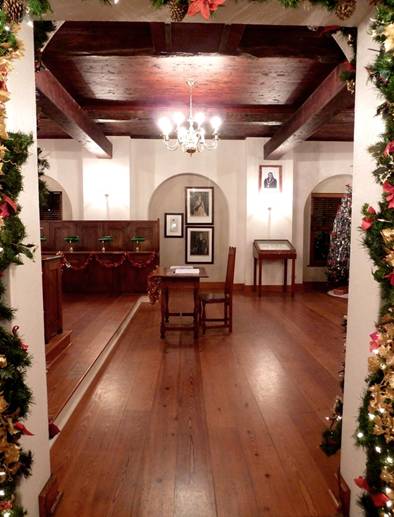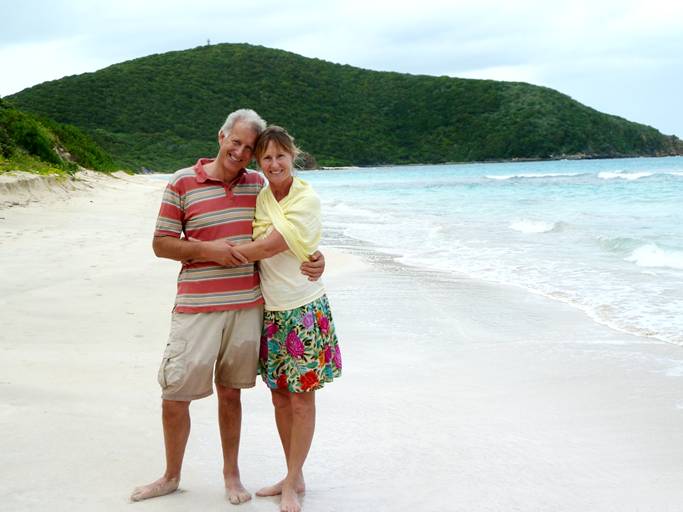Location: 18 30.13 N 64 21.88 W
Our unplanned stop in Bermuda was a welcome respite from the windy north Atlantic weather. We spent time ashore and with friends, throwing in only a few boat jobs to salve the conscience. In the event, poor weather lengthened our stay to almost 3 weeks – time enough for 3 visits to the Swizzle Inn and for Stellie to make a new cockpit sun shade to protect us from the Caribbean sun. At over 4 metres long it's quite a substantial structure!
 |
| St Georges town hall, welcoming door open to all and lit for the walkabout festivities. |
Despite its economic problems, Bermuda remains a lovely island to visit. Cruise ship visits are down, and we were sorry to hear that some ships will only stay for less than one day. This may be because local Bermudian law prohibits the use of the onboard gaming machines – a valuable source of profit for the ship operators.
But economic hard times are nothing new for Bermuda. Centuries ago, Britain understood that this colony could never produce much in the way of goods or food for the empire. Its value was purely as a naval base to protect our valuable trade routes in the Caribbean. After losing all our possessions in the American War of Independence (1775 -83), Britain was left with just a toehold in the North Atlantic – Bermuda – with Halifax to the north and Jamaica to the south. So it was developed into an impregnable fortress to protect our trade. In 1812, tensions with America erupted into war, and attacks on Washington and Fort McHenry at Baltimore were launched from Bermuda.
 |
| This 9 inch rifled muzzle loader from the 1870's would probably discourage most intruders from sailing down Bermuda's north channel. Firing 400 pound shells from an enclosed 'Haxo' casement must have given the gunners a bit of an earache, though. |
Richard and Alison arrived on Vulcan Spirit. They had some autopilot problems so we helped them diagnose the problem - a faulty drive unit clutch – then eventually managed to fix it.
 |
| Inside the welcoming door to St Georges town hall |
But the best part of our extended stay was the magical St Georges Town Walkabout. Organised by the Bermuda National Trust, the walkabout is an annual event to celebrate the town's history and culture. This quaint town dates back to the early 1600's and is a UNESCO World Heritage Site.
For one evening, generous townspeople open up their beautifully decorated homes to the public, some of them very old indeed, and even offer visitors mulled wine and egg nog.
Entertainment was laid on in the town square. Whilst enjoying a chicken dinner with desert served by sea cadet volunteers, the town crier called us to attention as various dance groups, a Salvation Army band and a youth orchestra performed. In St Peter's, all the candelabra's were lit and the church was filled with the haunting sound of a hand bell choir.
The following evening there was yet another street event, but this time with more modern dancing and with Father Christmas in attendance.
 |
| Banyan tree near crystal caves, Bermuda |
At last it seems there is a possible weather opportunity for us to continue on our journey south. Although it's still rather windy, Vulcan Spirit sets off. Feeling rather tired and worn (the effects of a head 'cold', not alcohol!) we decide to wait till morning, even though there's a risk of being becalmed when the Bermuda 'high' - an area of high pressure - re-establishes itself.
Is there something there?
At 7am the next morning, we weigh anchor and set off into 25 knot winds and a 4 metre swell. There's nearly 1000 miles to go as we race to the south to try and beat the high pressure system. Thankfully the strong winds persist, and for the next 48 hours we make fast progress on a beam reach, though with poor radio propagation we are unable to check the weather forecast with Herb. But an unpleasant surprise awaits us.
At 0400hrs one morning, Stellie hears a curious tinkling sound on deck. Too early for Santa with his sleigh. But what can it be? She wakes me and we investigate together. Looking out into the darkness we think we can make out something large on the foredeck. The penny suddenly drops. Keith rushes inside to trip the main switch to the anchor windlass and the noise subsides.
The problem? A deck switch had malfunctioned, causing the anchor windlass to operate on its own and feeding out chain from the chain locker onto the foredeck. Now there's 60 metres of heavy chain piled up on the foredeck. Thankfully none of it had gone over the side. A minute longer and all 112 metres would have paid out to the bitter end – the inboard end of the chain which is made fast to the yacht. This would certainly have damaged the winch motor and risked the whole caboodle going overboard.
The next job is to retrieve the chain and put it all back into its locker. We reef both sails heavily, don full wet weather gear and safety harnesses and then head forwards on the slippery deck. By chance there's a momentary lull in the wind, allowing us to avoid a soaking as we manually feed the chain back into its locker below deck.
Wot lighthouse?
The next day the wind howls with steep seas but we speed on, heavily reefed, and 24 hours later the wind abates sufficiently to set more sail, easing our ride considerably. Our plan is to make landfall at night near the low-lying island of Anegeda, which boasts a lighthouse on its NW tip. We approach the island and its coral reef carefully in the blackness of an unlit sky, arriving before the moon has arisen. We want to check our GPS position visually, but as we get closer, it becomes apparent that this lighthouse – the first to be encountered after 1000 miles of ocean, isn't working! So we check our position using a combination of radar and depth soundings and safely slip around the tip of the island into the shelter of its coral reef.
By midnight, we are safely anchored off Spanish Town, Virgin Gorda and drinking chocolate in the cockpit. The warm breeze carries new scents of land, reggae music plays loudly from ashore and the boat rolls gently in the swell. No matter – after nearly 6 days at sea we're so tired we'll sleep through anything!
 |
| Ananda anchored of Virgin Gorda, Spanish Town, sporting her original white sun awning. Quite a handful to set up but loads of shade. Behind us is the slightly larger Club Mediterranee 2 offering 'ballroom dancing, bridge and music'. Alors, pas de difference... |
 |
| Club Med 2 sails into the sunset |
After a few days rest and quite a lot of rolling in this rather exposed anchorage, we sail around to the north of the island past
Necker Island – Richard Branson's privately owned Virgin isle – and into
Gorda Sound. The sound is sheltered, almost landlocked, and is a beautiful setting amidst unspoiled islands. We anchor off the mangroves on uninhabited
Prickly Pear Island, and land our dinghy nearby on the deserted pristine beach. Land crabs scurry everywhere as we tread carefully towards the salt water lagoon 50 metres inland. Incredibly, there is a small colony of flamingos resident there! Sadly these shy birds are now uncommon in the Caribbean, much of their natural habitat now lost with increasing land development. This colony must be an offshoot of the larger colony on
Anegada.
 |
| Close to Ananda, flamingos forage on Prickly Pear Island |
 |
| A seaplane lands near David Geffin's yacht Rising Sun |
No wonder the place is popular with the super-rich. This weekend is Holly Branson's wedding on Necker Island and the place is buzzing, many of the guests staying at nearby resorts. We have impressive company in this lovely anchorage.
 |
| A helicopter lands on Larry Page's expedition yacht Senses. |
Just behind us is '
Senses', a 194 foot expedition motor yacht owned by Larry Page, the 39 year old co-founder and now chief executive of Google. Was he at the wedding? His own wedding took place at Necker only a couple of years ago.
Next to him is
Rising Sun, a massive 450 feet and privately owned by the legendary (notorious?) showbiz mogul David Geffin. Not only founder of Asylum Records (Joni Mitchell/Crosby Stills and Nash/Bob Dylan/Tom Waites/Eagles), as co-founder of Dreamworks, he is big in Hollywood.
Hard to think of a better place to celebrate our 30th wedding anniversary. On the great day we hire a car with Richard and Alison and tour the island, swimming off lovely beaches.
 |
| Hats galore. Lunch overlooking the Baths at Virgin Gorda - 30 years of marriage today! |
 |
| Gorda Sound anchorage. Ananda is the white yacht with 3 spreaders, anchored just below and to the right of the tiny resort of Saba Rock. The lagoon with the flamingos is visible on Prickly Pear Island to the left of the picture. |
When it comes to eating out, there's no shortage of choice. Built on an isolated rock behind a reef lies what must be one of the tiniest complete resorts,
Saba Rock, complete with hotel, vintage boats and outboard engines and tame toucans. During 'happy hour', their rum-laced 'painkillers' certainly achieve their aim. And there's the
Bitter End resort, sophisticated with music, small cinema and every kind of water sport activity available. Across the lagoon is Leverick Bay, another resort where Branson keeps
Necker Belle, his giant catamaran. Except in settled weather, it's too rough to moor the yacht off his own island.
 |
| Branson's Necker Island, with Necker Belle anchored off for the wedding. Sadly, his home (centre of the photograph) was completely destroyed by fire in August 2011 and has now been partially rebuilt. |
 |
| Stellie in beach mode |
 |
| Anniversary on the beach - quite a contrast to the deep snow of our wedding day. |
There's plenty to explore on foot too. A long walk along a hilly trail led us to Oil Nut Bay where a new development is nearing completion.
 |
| Development marches on relentlessly. The almost completed Oil Nut Bay resort boasts amazing facilities. You can build your own exclusive home here. |
So, all in all, not a bad place to be holed up, despite the rather windy weather. Stellie has baked mince pies, the freezer is well stocked so we probably won't be moving far for a while.
 |
| A beautifully situated telegraph pole somewhere in the Virgin Isles. Composition is all... |
* * * * *






























































